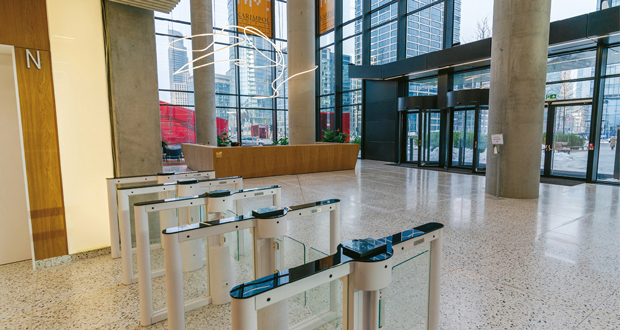Jaroslav Barton, HID’s Product Marketing Director for Physical Access Control, says the uptake of smartphone-based solutions offers tangible benefits, as seen in a case study on the Skyliner skyscraper in Warsaw, Poland
Facility managers have always had to cope with what appears to be mutually exclusive demands. Not only do they have a wide remit to juggle—whether that’s maintenance, cleaning, mailroom, reception, security and so on—but they’re tasked with providing these services at the right quality, the right time and at the right price. It’s tough to do.
COVID-19 has added another complicating dimension for them. Initially, facility managers had to rapidly respond to introduce health and safety protocols to guarantee a safe working environment. Now they have to cope with a whole new employment paradigm, namely hybrid-remote working, which is making the workplace significantly more dynamic, fluid and complex.
Pre-pandemic, the norm was for most employees to work on-site. It was therefore easier to offer access to a building and forecast its utilisation. Today, employees are in and out all the time and work remotely, capitalising on the latest unified communications apps like Zoom and Microsoft Teams.
Data from the Office of National Statistics supports this. It shows that hybrid work is very much here to stay, with 84 per cent of people who took up home working because of COVID-19 saying they plan to carry out a mix in the future and work both from home and at their place of employment.
The knock-on effect for facility managers is considerable. They need efficient and easy ways of managing building access whilst grappling with today’s more strategic challenges such as delivering against stringent environmental, social and governance (ESG) goals.
EVOLUTION OF ACCESS CONTROL
The role and benefit of access control has changed markedly in recent years. No longer is it just a way to prevent entry to a building by unauthorised people. As the technology has evolved, it is playing a far greater part to enhance the operational engineering, maintenance and functioning of buildings.
A key enabler of this change is the option to transition away from using physical plastic access cards – which utilise RFID technology – to smartphone – based solutions, along with wearables like smart watches. These then leverage virtual credential technology connecting to mobile-enabled door readers to allow people to enter.
A raft of benefits can be gained from these mobile access solutions, unlocking the potential for smarter, greener and more efficient buildings.
SIMPLIFIED MANAGEMENT
Any iOS or Android device can be used, with software-based management running in the cloud making it straightforward to then deal with the licencing, allocation of virtual credentials, setting of building access rights, validating or revoking of IDs remotely and dealing with visitors or contractors. The upshot? Mobile access solutions make life easy for time-pressed facility managers as they’re much simpler and more efficient to manage and use.
Products that are interoperable and support common industry standards are readily available, too. Using open APIs and software development kits (SDKs), integration is simplified, enabling corporate real estate (CRE) owners to create an ecosystem of solutions to manage their buildings, while avoiding vendor lock-in. This makes them easy to integrate with HR, IT, HVAC, time attendance, lighting and other systems that combine to make up smart buildings.
Transitioning to mobile access is straightforward. The door readers installed need to be checked. The latest models support mobile access out-of-the-box. Others can be upgraded [really old ones have to be replaced]. It’s then just a case of obtaining and installing the mobile access solution – a smartphone app and server-side tools – and integrating this with whatever building management or security systems are in place. Many readers support both physical cards and virtual credentials so that staged roll outs are possible. This is ideal in large buildings with multiple tenants where a ‘big bang’ switchover would just be too complicated.
MOBILE ACCESS BENEFITS
Mobile-based credentials and door readers support the latest encryption, communications and authentication standards – to establish trusted identities – just like physical access cards. Mobile has key advantages. First, users take far more care looking after their expensive smartphones compared to plastic access cards; research shows a whopping 17 per cent are lost or mislaid every year. Each time this happens, it creates a security risk.
Second, if someone does indeed lose their smartphone, they’ll clock this far more quickly (who can function without a phone these days?!) with their digital credential then able to be quickly disabled wirelessly. This remote management capability with mobile access is fundamentally the important advantage.
It is estimated that more than 550 million PVC access cards are made and sold annually each year, creating 2,700 tons of plastic waste and emitting 11,400 tons of carbon emissions. It is a significant amount especially as so many cards have to be  replaced regularly. Digital credentials remove this environmental overhead in one fell swoop, helping boost a building owner’s sustainability initiatives and ESG Index scores.
replaced regularly. Digital credentials remove this environmental overhead in one fell swoop, helping boost a building owner’s sustainability initiatives and ESG Index scores.
With support for both Bluetooth and NFC- two technologies enabling data transfer over short distances – mobile access solutions also provide touchless entry like traditional physical cards. This makes it as fast for people to open doors, and – in the context of COVID-19 infection prevention – there’s an obvious health benefit given door reader surfaces aren’t continually touched, nor do they have to be constantly cleaned.





